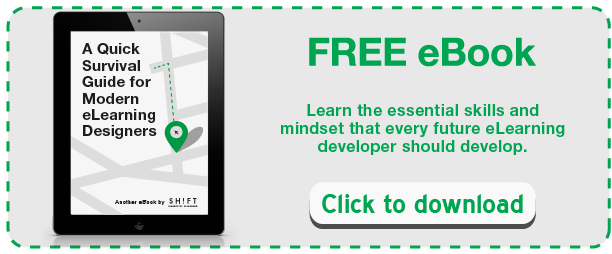eLearning professionals need to raise the bar and reset their expectations if their learners are to consider courses worthwhile. The following ten points are things we have found successful eLearning professionals do differently. We hope they can help developers change their mindsets to create the best courses possible.

1. They Make it a Goal to Learn About Their Audience.
Successful eLearning developers know what motivates their learners to take online courses instead of spending their time on other activities. They find out what students love, like, and dislike about their organizations. The simple solution to find these answers is to ask.
2. They Think of Learners as Social Individuals
Thinking of learners as more than computer users, and instead as social individuals is even more important in eLearning than traditional learning situations due to the physical barrier. Successful eLearning developers go beyond understanding learners’ needs and requirements. They also make sure instruction is designed to suit the context in which they learn.
3. They've Stopped Thinking That Learners Have Unlimited Time and Attention Spans
In almost all courses, learners want the course to get to the point sooner, wrap up faster, and finish earlier. Students have limited time, energy, and attention to spend on an eLearning course, and course design needs to recognize this.
Helping students to pay attention is a primary concern of successful eLearning professionals. Here are some methods they use to win the attention game in eLearning.
4. They Design with the Brain In Mind
Successful eLearning professionals understand how the memory works, how the brain learns and create their courses accordingly. Spaced learning, for example, is a strategy that aligns learning with memory formation rather than trying to force content into memory. For more information about spaced learning, developers should check out Brain Rules by John Medina.
5. They Utilize Quiet Design
In quiet design, everything on a screen has a purpose. This reduces time learners spend away from learning when processing unnecessary visuals or trying to work out an interface.
To properly utilize quiet design, successful eLearning developers keep information to a minimum, favor graphics over text, and place an explanatory text near visuals, to emphasize that the two are related. They use the most logical and concise way to present content even if this means significantly reorganizing the current design.
Even color can send a strong message, and the overuse of color can decrease learners’ performance. Once again, it is important to be minimal when it comes to using color, utilizing it deliberately to direct attention to the most important elements at the right times.
6. They Embrace a Beginner’s Mind
The beginner’s mind is a concept from Zen and refers to a state of mind free from preconceptions, from false confidence, and from self-criticism and doubt. It is a state of genuine curiosity and eagerness to learn.
In other words, having a beginner’s mind is about being comfortable not knowing, being open to new perspectives and ideas, and committing to continuous learning rather than looking to meet specific goals. This last point is particularly important in eLearning as those professionals who do not seek to expand constantly their knowledge fail to develop the necessary skills needed for a changing environment and soon get left behind.
7. They Think Beyond the Course
Successful eLearning professionals don’t think of eLearning as an event. Instead of delivering information to learners through the course alone, they think how they can provide content periodically to help students synthesize information.
8. They Are Authentic and Problem-based
To increase the likelihood that students absorb information from the eLearning course, successful professionals know why they need this knowledge and what real-world value it holds. Every moment of an eLearning experience should be valuable. Developers aim to present the right information at the right time to the right learners and empower students to decide what and where they want to learn.
9. They Focus on Quality
An eLearning course can be crafted quickly, but to have long term results you have to have quality. First and for most you have to have quality content. Quality content, quality visuals, quality writing. This can’t happen by throwing content together.
Even the best design is no compensation for poor content; to withstand the test of time, eLearning courses must be of high quality as a superficial, decorative course quickly loses the audience. Successful eLearning professionals place a higher value on content than aesthetics and remember that function is far more important than looks; for instance, by engaging learners from the start with a learning activity that allows the audience to explore, learn from their mistakes, and apply the lessons to real life.
10. They Have Strong Instructional Design Foundations
Although graphic design is useful, instructional design is essential as it focuses on the small details, which can make the different between a highly successful course and a complete failure. Instructional design is a key aspect of any eLearning course. Contrary to what many developers believe, it goes far beyond presenting content, breaking information down into separate lessons and units, and selecting a series of topics to make up a course. Rather, instructional design should be about:
- Setting goals and objectives to guide learners’ focus
- Providing context and perspective while compressing information to just the most essential to save time
- Choosing the most appropriate subjects, resources, types of media, and technology
- Planning assessment tasks and other activities
These components all combine to create a holistic learning experience.








